Bibliography Background About KRIS
Hypothesis #2: High levels of sediment in Noyo River tributaries have caused habitat changes which limit coho salmon production.
Support for hypothesis from the literature
It is widely acknowledged that sedimentation can limit salmonid reproduction and survival (see Sediment page). In the Noyo River, levels of fine sediment in gravels are well over thresholds for optimal coho egg and alevin survival, the relative frequency of pools is low and pools are shallow. All three factors can limit coho salmon production.
Chapman (1988) recognized that fine sediment in redds can limit salmon and steelhead production but stated that not enough experiments had actually been conducted to measure conditions within redds. McHenry et al. (1994) built artificial redds in Olympic Peninsula streams and placed coho salmon and steelhead eggs in them. They found that: "When fine sediments (<0.85 mm) exceeded 13%, salmonid survival dropped drastically. This suggests the existence of a threshold over which survival is very low." Although some fine sediment is removed when the female coho digs the redd, particles less than 0.85 mm are highly mobile and may re-enter the redd, even during moderate flows, if they are at very high levels in the stream bed (Beschta and Jackson, 1979).
Burns (1972) found that fine sediment less than 0.8 mm in the Little North Fork Noyo River made up 20% of the stream bed prior to the re-initiation of logging in 1966. He noted that fines increased to 31% and 33% (<0.8 mm) after logging and streamside road building in 1968 and 1969, respectively. Valentine and Jameson (1994) found that sediment less than 0.85 mm comprised 21-31% of the substrate during extensive sampling of potential salmonid spawning gravels in the Little North Fork Noyo River in 1992, with an average level of 25.6%. They sampled pool tail crests but skipped locations where conditions were "clearly not suitable for spawning", which would bias samples toward lower values. Habitat typing surveys include visual estimates of embeddedness to characterize spawning gravel quality (CDFG, 1995-96; GP, 1996). Good spawning habitat is less than 25% embedded (CDFG, 1998), but many Noyo River surveys estimate embeddedness levels greater than 75%. According to a Georgia Pacific (1996c) survey, embeddedness levels in the Little North Fork Noyo were greater than 75% at almost all habitats (see chart below). Therefore, fine sediment in the Little North Fork Noyo River is elevated and at levels which are likely to be deleterious to coho salmon egg and alevin survival.
Habitat typing reports from the California Department of Fish and Game (1995, 1996) and from Georgia Pacific (1996) show pool frequencies below 30% in many Noyo River tributaries. Murphy et al. (1984) found pool frequencies of 39-67% in undisturbed streams. Pudding Creek, which is part of the KRIS Noyo project, had only 28% pools by length (GP, 1996). Historical stream surveys (CDFG, 1965) found that pools constituted "ninety-five per cent of summer flow" in Pudding Creek, and that "because of abnormally slight gradient, any barrier to flow tends to cause long, deep pools." Brown et al. (1994) noted the importance of having pools deeper than a meter (39 inches) for coho juvenile rearing and stated that loss of pools was a principal cause for loss of coho salmon in northwestern California. Valentine and Jameson (1994) found no pools deeper than three feet in the Little North Fork Noyo River in 1992. Knopp (1993) found that fine sediment filled approximately 60% of pool volume in Kass Creek, in the Noyo Basin, and approximately 75% of pool volume in Pudding Creek. Therefore, pools are less frequent and shallower than they were historically and the lack of quality pools is negatively affecting coho in the Noyo River and Pudding Creek.
From Noyo Data
Source Topics: The charts below are derived from the Topics listed here. Check these Topics in the KRIS database to see information in context and to have access to InfoLinks and Metadata.
(MN) Sediment: Fines <0.8 mm Little NF Noyo Burns 1966,68,69
(MN) Sediment: Fines <0.85 mm Little NF Noyo 1992
(MN) Habitat Typing: Little North Fork Noyo Embeddedness
(SF) Habitat Typing: Kass Creek Embeddedness
(PC) Habitat Typing: Pudding Creek Percent by Length
(MN) Habitat Typing: Duffy Gulch West Branch Percent by Length
(LN) Sediment: Knopp V* Results Noyo & Nearby Streams
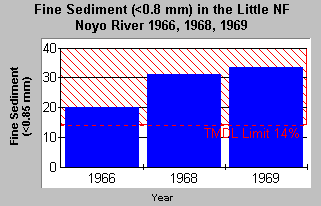 |
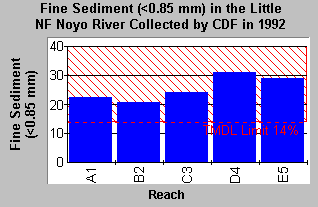 |
|---|---|
| This chart shows fine sediment levels in the Little North Fork River as measured by Burns (1972). Fine sediment levels rose from 20% in 1966, to 31% in 1968, and to 33% in 1969. Burns ascribed this to streamside logging and road building, and to tractor skidding in tributary channels. NCRWQCB (1999) TMDL threshold shown for reference. | Valentine and Jameson (1994) measured fine sediment in potential salmon spawning gravels at five stations in the Little N.F. Noyo in 1992 and found the values shown above. Samples were not taken from areas that were not suitable for salmon spawning, which may have bias results low. The current Noyo TMDL limit for fine sediment of 14% is shown for reference. |
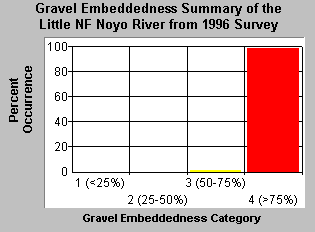 |
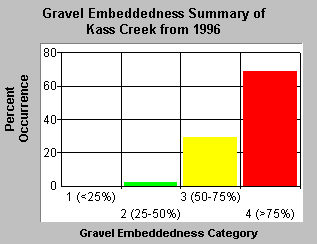 |
|---|---|
| Embeddedness describes the extent to which streambed gravel is buried in sediment. According to CDFG (1998), optimal salmon spawning gravels are less than 25% embedded. The values shown above were visual estimates made during a 4.3 mile stream survey conducted by Georgia Pacific. The surveyed reaches contained no gravel suitable for spawning and 99% of the gravel was more than 75% embedded. Data from Georgia Pacific (1996c). | In Kass Creek, a tributary to the South Fork Noyo River, Georgia Pacific found no gravels less than 25% embedded in the 1.9 stream miles that were surveyed, which is the category recognized by CDFG (1998) as suitable for salmonid spawning. Data from Georgia Pacific (1996b). |
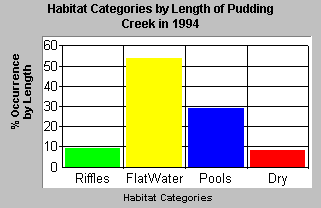 |
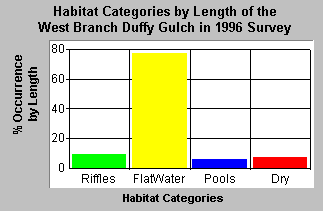 |
|---|---|
| A survey of 11.9 miles of Pudding Creek conducted by Georgia Pacific in September, 1994 found that 54% of the stream was flat water and 8% was dry. Pools comprised 29% and riffles 9% of the stream by length. A CDFG (1965) noted that pools constituted 95% of habitats. The lack of pools and frequency of dry habitats is likely impairing coho production. Data from Georgia Pacific (1995). | In September, 1996, Georgia Pacific surveyed 0.6 miles of the West Branch of Duffy Gulch and found that it was 72% flatwater, 6% pools and 7% dry, by length. Because of the lack of pools, this stream is currently very poor habitat for coho and older age classes of steelhead. Data from Georgia Pacific (1996g). |
Knopp (1993) used V* techniques to measure sediment in pools in Noyo River tributaries and other nearby streams. Those streams with a high proportion of pool volume filled with sediment are likely to be impaired with regard to coho salmon juvenile production. The Noyo River TMDL (NCRWQCB, 1999) threshold of 0.21 is shown for reference.
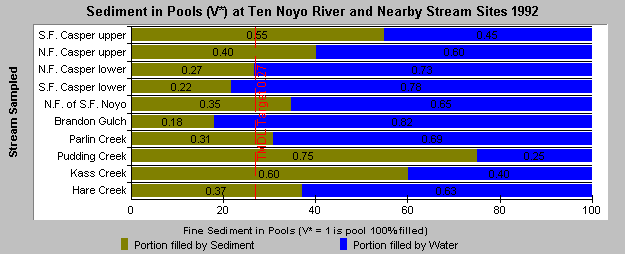
Alternative Hypotheses
Fine sediment measurements in 1992 were not representative because they were elevated by drought.
Support for this hypothesis comes from discussions in Valentine and Jameson (1994). This hypothesis could be tested by collecting fine sediment data at all locations in the Little North Fork Noyo River over several years, similar to the suggested method for testing the principal hypothesis advanced on this page.
Alternative Hypotheses #2A Sediment in the Noyo River is near normal background levels
For support of this alternative hypothesis see Valentine and Jameson (1994).
Monitoring Trends to Support or Refute the Hypothesis
Establish a monitoring program to check trends in pool depth, sediment in pools (V*) and standing crops of juvenile coho. Check for trends of increase or decrease in coho numbers or biomass as pool volumes fluctuate. If coho salmon juveniles increased in number or biomass with increasing pool depth, it would support the hypothesis. (Necessary to consider confounding factors such as high water temperature, varying levels of large wood or cover, etc.)
Monitor trends in fine sediment adjacent to coho redds in various Noyo River tributaries using McNeil samples or freeze cores, then use nets over the redds to capture emerging fry. Relationships between fines and survival to emergence would support the hypothesis.
Monitoring to test the weight of evidence for this hypothesis could be part of TMDL implementation: 1) implement erosion control measures, 2) monitor sediment (V*, McNeil samples) and, 3) track coho response with fish sampling.
References
Barnard, 1992. Physical and Chemical Conditions in Coho Salmon (Oncorhynchus kisutch) Spawning Habitat in Freshwater Creek, Northern California. Masters Thesis. Humboldt State University, Arcata, CA. 81 p. plus appendices.
Beschta, R.L. and W.L. Jackson. 1979. The intrusion of fine sediments into a stable gravel bed. Journal of the Fisheries Research Board of Canada 36:204-210.
Brown, L.R., P.B. Moyle and R.M.Yoshiyama, 1994. Historical Decline and Current Status of Coho Salmon in California. Norht American Journal of Fisheries Management. 14( 2) 237-261.
Burns, J. 1972. Some Effects of Logging and Associated Road Construction on Northern California Streams. Transactions of the American Fisheries Society, Vol. 101, No. 1: 1-17.
California Department of Fish and Game. 1965. Pudding Creek Stream Survey Report. CDFG, Region 3, Yountville, CA. 6 p.
California Department of Fish and Game. 1967. Duffy Gulch Stream Survey Report. CDFG, Region 3, Yountville, CA.
California Department of Fish and Game. 1995a. Habitat Typing Report : Parlin Creek, South Fork Noyo Basin. CDFG, Region 3, Yountville, CA.
California Department of Fish and Game. 1995b. Habitat Typing Report : South Fork Noyo River. CDFG, Region 3, Yountville, CA.
California Department of Fish and Game. 1995c. Habitat Typing Report : Unnamed Parlin Creek tributary #A, South Fork Noyo Basin. CDFG, Region 3, Yountville, CA.
California Department of Fish and Game. 1995d. Habitat Typing Report : Unnamed Parlin Creek tributary #B, South Fork Noyo Basin. CDFG, Region 3, Yountville, CA.
California Department of Fish and Game. 1995e. Habitat Typing Report: Unnamed Parlin Creek tributary, locally known as Waldo Gulch. CDFG, Region 3, Yountville, CA.
California Department of Fish and Game. 1996a. Habitat Typing Report : Brandon Gulch, SF Noyo Basin. CDFG, Region 3, Yountville, CA.
California Department of Fish and Game. 1996c. Habitat Typing Report : North Fork of South Fork Noyo River. CDFG, Region 3, Yountville, CA.
California Department of Fish and Game. 1996d. Habitat Typing Report: Unnamed North Fork of South Fork Noyo River tributary. CDFG, Region 3, Yountville, CA.
California Department of Fish and Game. 1998. California Salmonid Stream Habitat Restoration Manual. Third Edition. Inland Fisheries Division. California Department of Fish and Game. Sacramento, CA. 495 p.
Chapman. D.W. 1988. Critical Review of Variables Used to Define Effects of Fines in Redds of Large Salmonids. Transactions of the American Fisheries Society. 117: 1-21.
Georgia Pacific. 1995. Habitat Typing Report: Pudding Creek. Georgia Pacific, Ft. Bragg, CA.
Georgia Pacific. 1996a. Habitat Typing Report: Duffy Gulch, Middle Noyo River Basin. Georgia Pacific, Ft. Bragg, CA.
Georgia Pacific. 1996b.Habitat Typing Report: Kass Creek. Georgia Pacific, Ft. Bragg, CA.
Georgia Pacific. 1996c. Habitat Typing Report: Little North Fork Noyo River. Georgia Pacific, Ft. Bragg, CA.
Georgia Pacific. 1996d. Habitat Typing Report: Mainstem Noyo River. Georgia Pacific, Ft. Bragg, CA.
Georgia Pacific. 1996e.Habitat Typing Report: Switchback Gulch, a Noyo River tributary. Georgia Pacific, Ft. Bragg, CA.
Georgia Pacific. 1996f. Habitat Typing Report: Unnamed Tributary to Duffy Gulch, Middle Noyo River Basin. Georgia Pacific, Ft. Bragg, CA.
Georgia Pacific. 1996g. Habitat Typing Report: West Branch Duffy Gulch, Middle Noyo River Basin. Georgia Pacific, Ft. Bragg, CA.
Knopp, C. 1993. Testing Indices of Cold Water Fish Habitat. Final Report for Development of Techniques for Measuring Beneficial Use Protection. North Coast Region Water Quality Control Board in cooperation with California Department of Forestry. 57 pp.
McHenry, M.L., D.C. Morrill and E. Currence. 1994 . Spawning Gravel Quality, Watershed Characteristics and Early Life History Survival of Coho Salmon and Steelhead in Five North Olympic Peninsula Watersheds. Lower Elwha S'Klallam Tribe, Port Angeles, WA. and Makah Tribe, Neah Bay, WA. Funded by Washington State Dept. of Ecology (205J grant).
Murphy, M.L., J.F. Thedinga, K.V. Koski and G.B. Grette. 1984. A stream ecosystem in an old growth forest in southeast Alaska: Part V. Seasonal changes in habitat utilization by juvenile salmonids. In Proceedings of Symposium on Fish and Wildlife in Relationships in Old Growth Forests. Eds. W.R. Meehan, T.R. Merrill and T.A. Hanley. Amerian Institute of Fishery Research Biologists, Asheville, North Carolina.
North Coast Regional Water Quality Control Board. 1999 . Noyo River Total Maximum Daily Load for Sediment. US EPA Region 9, San Francisco, CA. 87 p.
Pacific Watershed Associates. 1999. Sediment Source Investigation and Sediment Reduction Plan for the Freshwater Creek Watershed, Humboldt County, California. Performed under contract to the Pacific Lumber Company. PWA, Arcata, CA. 94 p.
Valentine, B.E. and M. Jameson. 1994. Little North Fork Noyo Fishery Study, 1992. CA Department of Forestry and Fire Protection, Coast Cascade Region. Santa Rosa, CA. 48 pp.